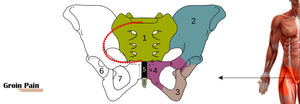 Welcome to the first edition of Dr Carolyn’s Research Corner. Each month I will summarise a research article related to pelvic instability and associated injuries and conditions. I have started with an article by Jan Mens and colleagues, which really influenced my thinking around groin pain and helped me develop my ideas when we were designing the Supacore Coretech leggings and shorts. I hope you enjoy my first article summary. Please feel free to send me any feedback or questions to info@supacore.com.
Welcome to the first edition of Dr Carolyn’s Research Corner. Each month I will summarise a research article related to pelvic instability and associated injuries and conditions. I have started with an article by Jan Mens and colleagues, which really influenced my thinking around groin pain and helped me develop my ideas when we were designing the Supacore Coretech leggings and shorts. I hope you enjoy my first article summary. Please feel free to send me any feedback or questions to info@supacore.com.
Mens, J., Inklaar, H., Koes, B., Stam, H. (2006). A new view on adduction-related groin pain. Clinical Journal of Sports Medicine, 16(1), 15-19. Doi: 10.1097/01.jsm.0000180869.37673.7b
Link to abstract
https://pubmed.ncbi.nlm.nih.
Why did the researchers do this study?
Groin pain is a common sporting problem, especially in soccer players. There are many different causes for groin pain, although it is often attributed to adductor tendinitis, which implies it is caused by an overuse injury of the adductor muscles. The researchers wanted to investigate their theory that not all groin pain is due solely to adductor tendinitis and there may be problems with the transfer of load through the pelvis (pelvic instability) that contributes to groin pain.
What did the researchers do?
The researchers recruited two groups of 44 male and female recreations athletes in their early 30’s. One group was healthy and had no groin pain (their control group). The other group was experiencing groin pain.
 The participants undertook two tests; an adductor squeeze test and an active straight leg raise test. For the adductor squeeze test, the participants laid on their back with their knees bent at 90o. The researchers placed a device that records muscle strength between their knees, called a hand-held dynamometer (HHD), and asked the participants to squeeze the HHD as hard as possible at least 3 times to achieve their best score. The squeeze test was done first without a pelvic belt, then repeated with a rigid pelvic belt placed around the pelvis and fastened firmly.
The participants undertook two tests; an adductor squeeze test and an active straight leg raise test. For the adductor squeeze test, the participants laid on their back with their knees bent at 90o. The researchers placed a device that records muscle strength between their knees, called a hand-held dynamometer (HHD), and asked the participants to squeeze the HHD as hard as possible at least 3 times to achieve their best score. The squeeze test was done first without a pelvic belt, then repeated with a rigid pelvic belt placed around the pelvis and fastened firmly.
For the active straight leg raise, the participants lay on their back and were asked to lift one leg off the table 20 cm without bending their knee. They were asked how hard the leg was to lift on a scale from ‘not difficult’ to ‘unable to do’. This was repeated for the other leg. The active straight leg raise was first done without a pelvic belt and then with the pelvic belt. The groin pain participants were also asked to rate the difference (1 to 3) between doing the test with no pelvic belt and having the pelvic belt.
What did the researchers find?
In the healthy group, without groin pain, there was no difference in adductor muscle strength for the squeeze test between not wearing the pelvic belt and wearing it. When the groin pain participants did the squeeze test without the pelvic belt, they were significantly weaker, but when they put the pelvic belt on and repeated the test, they were much stronger and were just as strong as the healthy participants (no significant difference). The majority of the groin pain group also had less pain with the pelvic belt on.
None of the healthy participants had a positive active straight leg raise test; they all found it easy to lift both legs. Seventeen of the groin pain participants had a positive active straight leg raise test and found it difficult to lift at least of their legs. When the pelvic belt was worn, all found it easier to lift their leg.
What does this mean?
The results meant not all groin pain is adductor muscle related. The ability of the pelvis to remain stable while muscles act on it to create force appears to be a factor. The pelvic belt had a positive affect on the pain levels of the groin participants and the muscle force they were able to generate. This suggests pelvic instability was contributing to their pain and muscle weakness, and by applying the pelvic belt, this instability was corrected. Therefore, external bracing of the pelvis to improve pelvic stability in people with groin pain is likely to be helpful and should be considered in the treatment and rehabilitation of groin pain.



